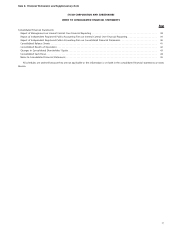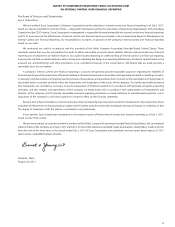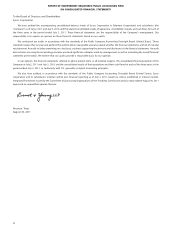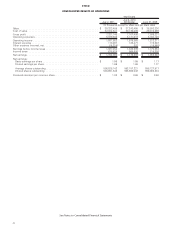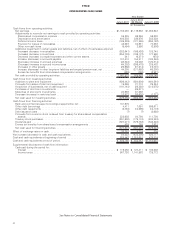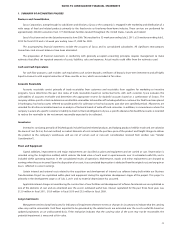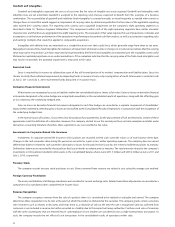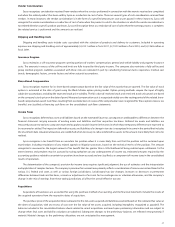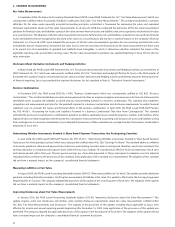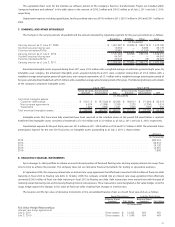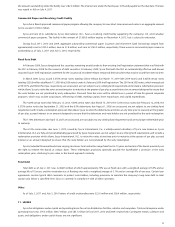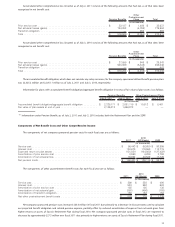Sysco 2011 Annual Report Download - page 70
Download and view the complete annual report
Please find page 70 of the 2011 Sysco annual report below. You can navigate through the pages in the report by either clicking on the pages listed below, or by using the keyword search tool below to find specific information within the annual report.Goodwill and Intangibles
Goodwill and intangibles represent the excess of cost over the fair value of tangible net assets acquired. Goodwill and intangibles with
indefinite lives are not amortized. Goodwill is assigned to the reporting units that are expected to benefit from the synergies of a business
combination. The recoverability of goodwill and indefinite-lived intangibles is assessed annually, or more frequently as needed when events or
changes have occurred that would suggest an impairment of carrying value, by determining whether the fair values of the applicable reporting
units exceed their carrying values. The reporting units used to assess goodwill impairment are the company’s eight operating segments as
described in Note 19, “Business Segment Information.” The components within each of the eight operating segments have similar economic
characteristics and therefore are aggregated into eight reporting units. The evaluation of fair value requires the use of projections, estimates and
assumptions as to the future performance of the operations in performing a discounted cash flow analysis, as well as assumptions regarding sales
and earnings multiples that would be applied in comparable acquisitions.
Intangibles with definite lives are amortized on a straight-line basis over their useful lives, which generally range from three to ten years.
Management reviews finite-lived intangibles for indicators of impairment whenever events or changes in circumstances indicate that the carrying
value may not be recoverable. Cash flows expected to be generated by the finite-lived intangibles are estimated over the intangible asset’s useful
life based on updated projections on an undiscounted basis. If the evaluation indicates that the carrying value of the finite-lived intangible asset
may not be recoverable, the potential impairment is measured at fair value.
Restricted Cash
Sysco is required by its insurers to collateralize a part of the self-insured portion of its workers’ compensation and liability claims. Sysco has
chosen to satisfy these collateral requirements by depositing funds in insurance trusts or by issuing letters of credit. All amounts in restricted cash
at July 2, 2011 and July 3, 2010 represented funds deposited in insurance trusts.
Derivative Financial Instruments
All derivatives are recognized as assets or liabilities within the consolidated balance sheets at fair value. Gains or losses on derivative financial
instruments designated as fair value hedges are recognized immediately in the consolidated results of operations, along with the offsetting gain
or loss related to the underlying hedged item.
Gains or losses on derivative financial instruments designated as cash flow hedges are recorded as a separate component of shareholders’
equity at their settlement, whereby gains or losses are reclassified to the Consolidated Results of Operations in conjunction with the recognition of
the underlying hedged item.
In the normal course of business, Sysco enters into forward purchase agreements for the procurement of fuel and electricity. Certain of these
agreements meet the definition of a derivative. However, the company elected to use the normal purchase and sale exemption available under
derivatives accounting literature; therefore, these agreements are not recorded at fair value.
Investments in Corporate-Owned Life Insurance
Investments in corporate-owned life insurance (COLI) policies are recorded at their cash surrender values as of each balance sheet date.
Changes in the cash surrender value during the period are recorded as a gain or loss within operating expenses. The company does not record
deferred tax balances related to cash surrender value gains or losses for the policies that Sysco has the intent to hold these policies to maturity.
Deferred tax balances are recorded for those policies that Sysco intends to redeem prior to maturity. The total amounts related to the company’s
investments in COLI policies included in other assets in the consolidated balance sheets were $231.3 million and $203.2 million at July 2, 2011 and
July 3, 2010, respectively.
Treasury Stock
The company records treasury stock purchases at cost. Shares removed from treasury are valued at cost using the average cost method.
Foreign Currency Translation
The assets and liabilities of all foreign subsidiaries are translated at current exchange rates. Related translation adjustments are recorded as a
component of accumulated other comprehensive income (loss).
Revenue Recognition
The company recognizes revenue from the sale of a product when it is considered to be realized or realizable and earned. The company
determines these requirements to be met at the point at which the product is delivered to the customer. The company grants certain customers
sales incentives such as rebates or discounts and treats these as a reduction of sales at the time the sale is recognized. Sales tax collected from
customers is not included in revenue but rather recorded as a liability due to the respective taxing authorities. Purchases and sales of inventory
with the same counterparty that are entered into in contemplation of one another are considered to be a single nonmonetary transaction. As
such, the company records the net effect of such transactions in the consolidated results of operations within sales.
46



